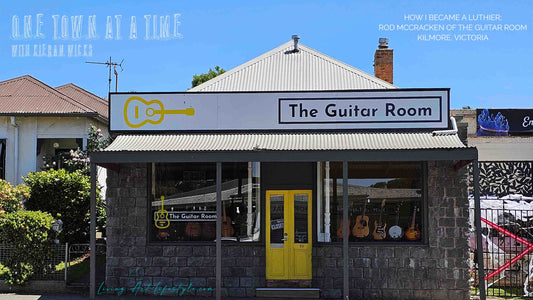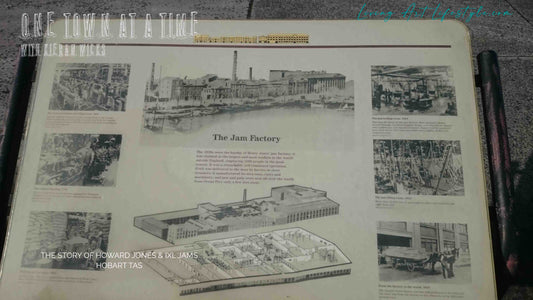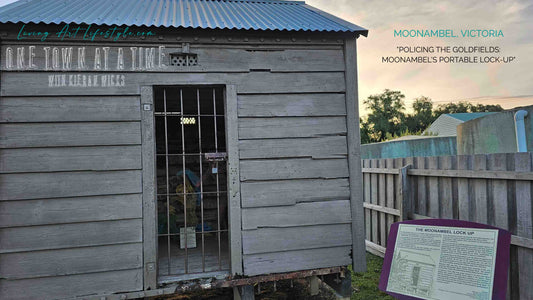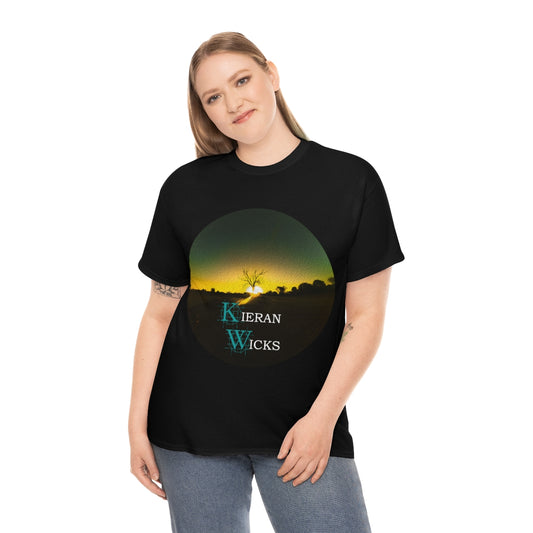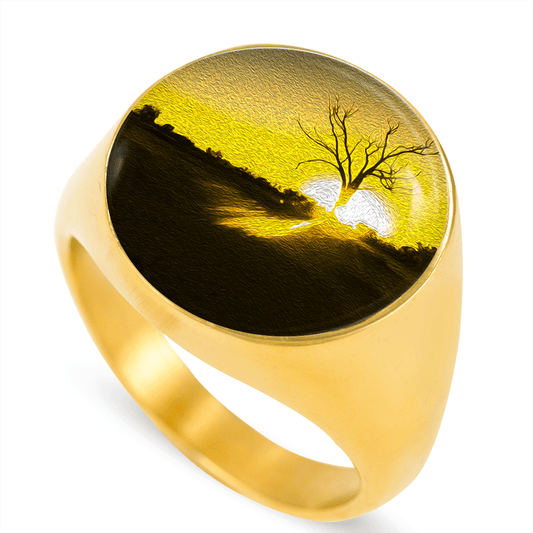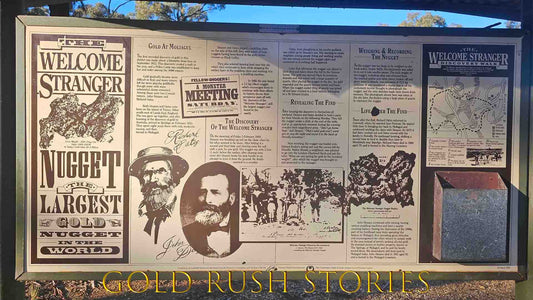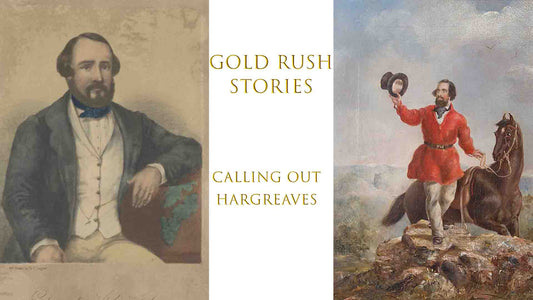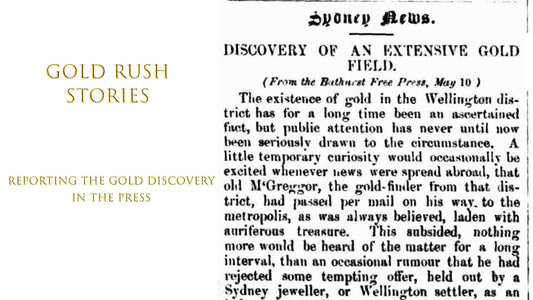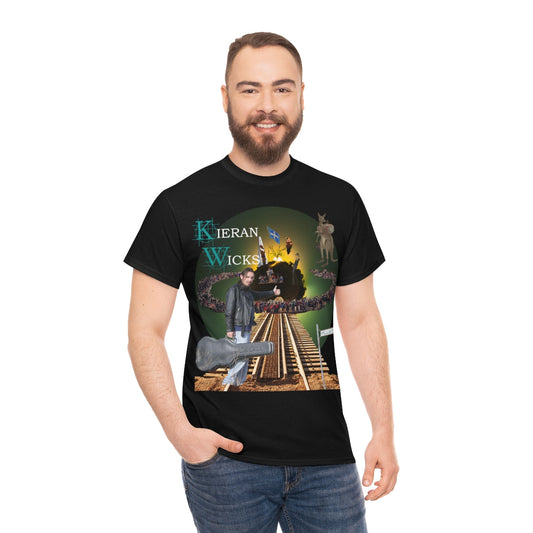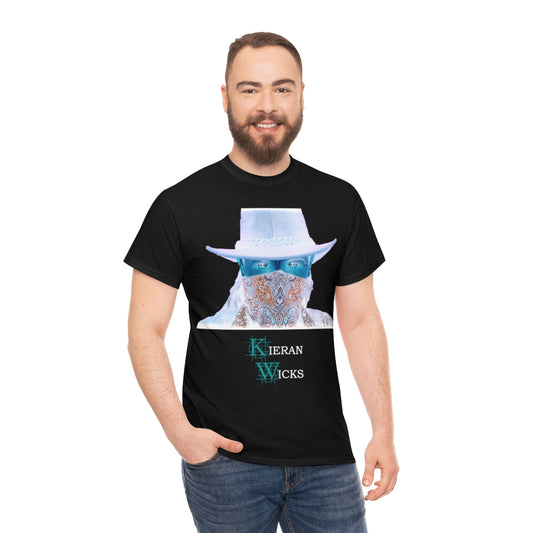
James Wilson Marshall and the Coloma Valley plaque at Marshall Gold Discovery State Historic Park in Coloma, California
Sarah Stierch (CC BY 4.0)
THE CALIFORNIA GOLD RUSH
On the 24th of January 1848, the world forever changed when James W. Marshall found gold at Sutter’s Mill in Coloma California.
This discovery would set off a chain of events that would secure America’s ascension and dominance as a world super power and economic powerhouse, the sudden population boom reinvigorating a flailing American economy, and facilitating California’s rise to statehood, in the Compromise of 1850.
Spanning from 1848 to 1855 the California Gold Rush was a virtual magnet for the near 300,000 drawn to California from across the globe.
Scholars estimate that approximately 90,000 people arrived in California in 1849, of which at least a third are estimated to have arrived from overseas, ballooning to over 300,000 hopeful souls by 1855.
(California Gold Rush, n.d.)

Ships Abandoned in Yerba Buena Cove San Francisco during the California Gold Rush 1849
WIYC, CC BY-SA 4.0 <https://creativecommons.org/licenses/by-sa/4.0>, via Wikimedia Commons
…There is no mystery as to the cause which so suddenly and so largely raised wages in California in 1849, and in Australia in 1852. It was the discovery of the placer mines in unappropriated land to which labor was free that raised the wages of cooks in San Francisco restaurants to $500 a month, and left ships to rot in the harbor without officers or crew until their owners would consent to pay rates that in any other part of the globe seemed fabulous.
…Henry George; Progress & Poverty Book V Chapter 2
(Gold Rush, n.d.)
Microfleece Hoodie Tree of Life Collection

Mining on the American River near Sacramento, circa 1852
George H. Johnson, Public domain, via Wikimedia Commons
DIFFERENCES IN THE GOLD RUSHES OF CALIFORNIA AND AUSTRALIA
The 1850s marked by far the greatest period of gold production the world had ever known, with Victoria alone producing a third of the world’s gold. New South Wales contributed an additional, comparably meagre, 5 per cent.
Approximated to be of comparable size in terms of mining population and gold production, the Californian and Victorian goldfields rapidly raised the world’s annual gold output by a factor of six or seven.
There was, however, a fundamental difference: in California the gold-seeking miners saw themselves as transient, whereas in Victoria they were more liable to remain, either staying as miners, moving to other Australian fields as fluctuating yields dictated, or settling into non-mining occupations. This is vividly illustrated by comparing the present-day landscape of the two goldfields – central Victoria, with its great gold cities, administrative centres, and public and commercial infrastructure, and the Californian mountains, with a myriad of small towns, some of these still inhabited but many others now ghost towns.
(Cultural Heritage Unit, n.d.)
Gullgraver 1850 California - A forty-niner peers into the slit of California’s American River.
Photo: L. C. McClure, Public domain, via Wikimedia Commons
IDENTITY CRISIS
Rather focused upon what riches the vast open pastoral lands had to offer the fledgling economy, colonial administrators initially saw the discovery of gold as a hindrance if not an existential threat to colonial administration, concealing early discoveries to avoid a likely dislocation of the relatively small community, but various factors soon changed that policy.
Namely the mass exodus of a then dwindling population bounding the fence for the green gold fields of California from the rushes commencement in 1848, coercing the New South Wales colonial government to alter its position and encourage the exploration for and exploitation of payable gold.

Handbill of the California Emigration Society, Boston, advertising passage to
California "in a first-rate Clipper Ship." Published in 1856, it promoted the
economic opportunities to be found in the new El Dorado. On the verso, notice
was made of mining companies offering wages of "$4.00 per day and board to
steady workmen," testifying to the transformation of gold mining from individual
adventure to corporate enterprise. Courtesy Huntington Library, San Marino, Calif .
(Rawls, James J., and Richard J. Orsi)

An 1849 handbill from the California Gold Rush. (Wikicommons)
The Australian authorities, weren’t completely hapless, having learnt some valuable lessons since the beginning of the California Gold Rush in 1848, and as such were understandably hesitant of revealing discoveries to the wider public.
But by 1849 the colonial government acquiesced and sought the approval of the Colonial Office in England to allow the exploitation of the mineral resources of New South Wales, with a subsequent reward being officially offered to the first person to find payable gold.
(New South Wales Gold Rush, n.d.)
In effect A 360-degree transformation was emerging on the perception of Australia as nothing more than a penal colony, somewhere to send society’s waste, to a land of riches and opportunity.
Tree of Life Collection Inner Desire Collection Flame Trees Collection
THE GOLD MEDAL; WHO WAS FIRST?
In addition to the Fish River find, there were many other reported findings before word got out to the rest of the world in 1851.
It was known by a select few that Gold was also found at:
- Strathloddon, Victoria in 1840
- Hartley, New South Wales in 1844
- Montecute, South Australia in 1846
- Glenmona Station, Victoria (near Maryborough) in 1849
(Australian Gold Rush, n.d.)
A convict who found gold near Bathurst in 1823 was given 150 lashes with a whip as it was believed he must have stolen it.

Paweł Edmund Strzelecki c1845
State Library of New South Wales, Public domain, via Wikimedia Commons
Famed Polish explorer Count Paul Strzelecki is also posited to have found gold in the Australian Alps in 1839, but kept it secret at the behest of the governor.
When Strzelecki published his book, „Physical Description of New South Wales and Van Diemen's Land,” in 1845, he omitted all reference to gold in accordance with the promise which he had given to the Governor. But his claim to priority in discovery is substantiated by two independent pieces of testimony.
First, an enclosure accompanying a despatch from Sir George Gipps in 1839 included amongst the minerals, found in New South Wales: „Gold, an auriferous sulphate of iron, partly decomposed, yielding a very small quantity or proportion of sold, sufficient to attest its presence”.
Secondly, in a debate in the Legislative Council of New South Wales in 1853, on a proposal to award a gratuity to Edward Hargreaves on account of his discovery of gold at Bathurst, James McArthur said that, to his knowledge Strzelecki in 1839 had exhibited specimens of gold to different gentlemen in Sydney, and “repeatedly told me in private conversation that an extensive goldfield existed in the Bathurst district ”.
(STRZELECKI FOUND GOLD BUT KEPT 1939, July 8)



STRZELECKI FOUND GOLD BUT KEPT (1939, July 8). The Courier-Mail (Brisbane, Qld. : 1933 - 1954), p. 7. Retrieved July 20, 2021, from http://nla.gov.au/nla.news-article40858032
More on Strzelecki finds
THE GURU COLLECTION HOODIE
If the pastoral industry was Australia’s first born, then Gold was its second born.
People tend to associate 'The Gold Rush' with California and the Klondike, but as a matter of fact the Australian gold rush remains the world's richest.
The presence of gold within Australia was known for many years prior to what is generally accepted to have been the onset of the Gold rush in 1851.
Spanning between 1851 and 1880, the New South Wales gold rush was Australia’s first, and whose origins centre around a claim shrouded in contention. The title of first discovery of ‘payable gold’ went to Edward Hargreaves. A distinction that carried with it a hefty reward and notoriety.
Whilst many letter writers wrote the claims off as a hollow victory.
On 12 February 1851, Edward Hargraves and his guide, John Lister, set out on horseback with a pan and rocking-cradle, to Lewis Ponds Creek, a tributary of the Macquarie River close to Bathurst, making their famed discovery, at a location Hargreaves would later name Ophir, recalling the moment, sharing that "once in the creek bed he somehow felt surrounded by gold".
(Taylor, 2003)

Edward Hargraves, gold rush publicist, ca. 1880-1884 photographer Henry King
NEWS OF HARGREAVES DISCOVERY




DISCOVERY OF AN EXTENSIVE GOLD FIELD. (1851, May 15). The Sydney Morning Herald (NSW : 1842 - 1954), p. 3. Retrieved July 20, 2021, from http://nla.gov.au/nla.news-article12927091
DISCOVERY OF AN EXTENSIVE GOLD FIELD.
INTERIOR
BATHURST
DISCOVERY OF AN EXTENSIVE GOLD FIELD. (From the Bathurst Free Press, May 10.,)
The existence of gold in the Wellington district has for a long time been an ascertained fact, but public attention has never until now been seriously drawn to the circumstance. A little temporary curiosity would occasionally be excited whenever news were spread abroad, that old McGreggor, the gold-finder from that district, had passed per mail on his way to the metropolis, as was always believed, laden with auriferous treasure. This sub-sided, nothing more would be heard of the matter for a long interval than an occasional rumour that he had rejected some tempting offer, held out by a Sydney Jeweller, or Wellington settler, as an inducement to disclose the secret of the locale, whence his treasure was derived. It is sufficient for the present purpose to state, that the progress he made in life with no other ostensible means of earning money than shepherding and gold-finding, has always been regarded as presumptive evidence of his success in the latter vocation.
The arrival of Mr. Hargraves in Bathurst on Tuesday evening last, who, it was generally known, had been in communication with Government respecting discoveries made by him of extensive gold deposits in our cis-montane region, has now brought the subject more prominently before the Bathurst public. On Thursday evening, he invited a few gentlemen to meet him at Mr. Arthur's Inn, with the object of communicating such information as he had obtained upon this interesting subject, in his recent explorations, and the readiness and intelligence which he displayed in answering the numerous questions addressed to him, showed satisfactorily that he not only possessed an intimate knowledge of gold mining in all its branches, but was desirous of giving every possible information upon the matter connected with his visit. From the running conversation which was kept up for several hours, we gleaned the following particulars.
Mr. Hargraves, who has spent nearly two years at the California diggings, returned to this colony in January last, having, as he states, whilst there, derived considerable information from the Mexican miners, whom he represents as by far the best and most successful diggers. Struck by the similarity of the geological formation and external physical characteristics of certain portions of this colony and the California gold fields, he was induced, at his own expense, and on his own responsibility, to visit this and the neighbouring districts, to institute a personal examination. His researches have been crowned with success. After riding about 300 miles, so as to intersect the country at numerous points, and spending from two to three months in the prosecution of his object, Mr. Hargraves states as the result of his observations, that from the foot of the Big Hill to a considerable distance below Wellington, on the Macquarie, is one vast gold field, that he has actually discovered the precious metal in numberless places, and that indications of its existence are to be seen in every direction, indeed, so satisfied is he on this point, that he has established a company of nine working miners, who are now actively employed, digging at a point of the Summer Hill Creek near its junction with the Macquarie, about 50 miles from Bathurst and 30 from Guyong. Ophir is the name given to those diggings.
Several samples of fine gold were shown to the company by Mr. Hargraves, weighing in all about four ounces - the produce, he stated, of three days' digging. The amount thus earned by each man he represented as £... 4s. 8d, per day, but he observed that from want of practical knowledge, and proper implements, he was convinced that nearly one-half of the gold actually dug had been lost, owing to the labour being performed in his absence. One of the samples produced was a solid piece, weighing about two ounces, and was found at the diggings attached to the root of a tree, by Mr. John Lyster, who is one of the company. Another sample consisted of small pieces, weighing from several grains to a pennyweight, all elongated, and of various shapes, and a third of small flat particles, principally oval. The large piece, which appears as if it had been in a state of fusion, is intended by Mr. Hargraves as a present to his Excellency the Governor. The only process through which the above samples had passed, was the washing, which had been performed by Mr. Hargraves himself.
The principal localities mentioned by Mr. Hargraves, where he had discovered gold, were Summer Hill, Guyong, and Lewis Pond Creeks. He also found gold at Dubbo, below Wellington, which he stated to be in powder, fine as the finest flour, but so far as he could judge from the opportunities he had, it did not exist in sufficient quantity to pay for the necessary labour. From the nature of some of the country explored by him, he is of opinion that gold will be found in mass, and would not be surprised if pieces of 30 or 40lbs. should be discovered. He had seen no country in California, which promised metal in such heavy masses. This description of country he represents as not being desirable as a field of speculation. One or two occupied thereon might be lucky enough to find a lump, but their companions will expend much toil and probably obtain nothing, whilst the ground which yielded the " dust" or larger particles could be calculated upon as returning a certain remuneration for a given quantity of labour.
We are assured by Mr. Hargraves that there exists an opening for an unlimited supply of labour in the vicinity of the diggings already opened by him, but he holds out no florid hopes, he makes no unreasonable or exaggerated statements. His arguments and representations simply amount to this, that there exists in the neighbouring, districts an extensive gold field, but whether a rich or remunerative field of labour he does not undertake to say. This question remains to be solved by actual trial.
We have now given the principal items of information connected with this most important and interesting subject. In the statements made we do not intend to incur any responsibility. We tell the story as 'twas told to us. The suddenness with which the announcement of a discovery of such magnitude has come upon us - a discovery which must, if true, be productive of such gigantic results not only to the inhabitants of those districts but to the whole colony, affects the mind with astonishment and wonder in such a manner as almost to unfit it for the deductions of plain truth, sober reason, and common sense. Mr. Hargraves is an intelligent, an educated, and we believe a respectable man. His manner is quiet and unobtrusive. He does not seek to thrust his information upon the people, but when questioned, answers modestly and intelligibly any questions put to him. The attention paid to him by Government is some guarantee of his respectability and his acquaintance with his subject, and there really does appear such an absence of any reasonable motive to mislead the public that if we do not comprehend all we have heard from him we are not prepared to disbelieve it. He started yesterday for Coombing, to join Mr. Stutchbury, the Government geologist, who, we are informed, will accompany him to the diggings. The matter will therefore be quickly placed beyond the reach of suspicion or incredulity.
THE MONOLITH - SANDLEWOOD WATCH

Edward Hammond Hargraves - Angas, George French, 1822-1886, Public domain, via Wikimedia Commons
CONJECTURE OVER WHO WAS FIRST
Countless letters to the editors of numerous publications during the initial days of the rush of 1851 dispute Hargreaves as the initial discoverer, questioning his claim to the reward offered for the first discovery of ‘payable gold’ in New South Wales.
LETTERS TO THE EDITOR


ORIGINAL CORRESPONDENCE – THE GOLD DISCOVERY
Sydney Morning Herald (NSW : 1842 - 1954), Monday 5 May 1851, page 2
ORIGINAL CORRESPONDENCE.
THE GOLD DISCOVERY.
To the Editors of the Sydney Morning Herald.
GENTLEMEN,—In this morning's Herald I find the following statement : - "It is no longer any secret that gold has been found in the earth in several places in the western country. The fact was first established on the 12th February, 1851, by Mr. E. H. Hargraves, a resident of Brisbane Water, who returned from California a few months since. While in California, Mr. Hargraves felt persuaded that, from the similarity of the geological formation, there must be gold in several districts of this colony, and when he returned his expectations were realized."
Here are two asseverations—one as to the date of the first discovery of gold in this colony; the other as to the method by which Mr. Har-grave is asserted to have made that discovery. The object of this letter is to deny to Mr. Hargrave the merit of the first discovery, or that he is the first person who was led to the conclusion that the similarity of formation in California and New South Wales indicated the presence of gold.
I almost wonder how you could have forgotten the many articles connected with this very subject which you have published long ago, even, I believe, before Mr. Hargraves went to California, in which a comparison is instituted between that country and this respecting this very matter of gold-finding. The Maitland Mercury bears testimony of a distinct date to the same fact.
Now, as to the assertion that it was on the 12th February, 1851, that the said fact was established, if you will turn to your own files you will find that on 28th September, 1847 the geological formation of this colony is investigated, and mention distinctly made of the existence of gold; and the article I allude to states, that from "facts communicated" (long before) to the Geological Society, Sir R. J. Murchison had already in a letter that had then been published in the Philosophical Magazine, addressed to Sir C. Lemon, his advice that "a person well acquainted with the washing of mineral sands, be sent to Australia, speculating on the probability of auriferous alluvia being abundant," and suggesting " that such will be found at the base of the western flanks of the Dividing Ranges."
The " facts communicated" were that gold had so been found; and some of that gold is still in my possession. Mr. Hargraves has therefore, merely acted upon suggestions thrown out years ago, and he has, there-fore, no claim as a " discoverer," The discoverer is he who first proclaims a fact. The fact in question was not first proclaimed by him. If any merit exists deserving reward, why should the cultivators of the science that leads others to riches be set aside? There are numerous localities in which gold has been found in this colony; but is the Government to pay every individual who picks up a handful of it? However, to confine myself to my immediate object, I deny again that either gold was first found in alluvia in this colony in 1851, or that Mr. Hargraves is the first person who indicated its existence from geological principles.
May 3.
ORIGINAL CORRESPONDENCE. (1851, May 5). The Sydney Morning Herald (NSW : 1842 - 1954), p. 2. Retrieved July 20, 2021, from http://nla.gov.au/nla.news-article12926829
THE CAPE COLLECTION - ROUND BEACH BLANKET


THE GOLD DISCOVERY
Maitland Mercury and Hunter River General Advertiser (NSW : 1843 - 1893), Wednesday 7 May 1851, page 3
THE GOLD DISCOVERY...
To the Editors of the Sydney Morning Herald.
GENTLEMEN—In this morning's Herald I find the following statement:—"It is no longer any secret that gold has been found in the earth in several places in the western country. The fact was first established on the 12th February, 1851, by Mr. E. H. Hargraves, a resident of Brisbane Water, who returned from California a few months since. While in California, Mr. Hargraves felt persuaded that, from the similarity of the geological formation, there must be gold in several districts of this colony, and of the first discovery of gold in this colony; the other as to the method by which Mr. Hargraves is asserted to have made that discovery.
The object of this letter is to deny to Mr. Hargraves the merit of the first discovery, or that he is the first person who was led to the conclusion that the similarity of formation in California and New South Wales indicated the presence of gold.
I almost wonder how you could have forgotten the many articles connected with this very subject which you have published long ago, even, I believe, before Mr. Hargraves went to California, in which a comparison is instituted between that country and this respecting this very matter of gold-finding. The Maitland Mercury bears testimony of a distinct date to
the same fact.
Now, as to the assertion that it was on the 12th February, 1851, that the said fact was established, if you will turn to your own files you will find that on 28th September, 1847, the geological formation of this colony is investigated, and mention distinctly made of the existence of gold; and the article I allude to states, that from "facts communicated" (long before) to the Geological Society, Sir R. J. Murchison had already, in a letter that had then been published in the Philosophical Maga-zine, addressed to Sir C. Lemon, his advice that "a person well acquainted with the washing of mineral sands, be sent to Australia, speculating on the probability of auriferous alluvia being abundant," and suggesting "that such will be found at the base of the western flanks of the Dividing Ranges.
The "facts communicated" were that gold had so been found; and some of that gold is still in my possession. Mr. Hargraves has, therefore, merely acted upon suggestions thrown out years ago, and he has, therefore, no claim as
a "discoverer." The discoverer is he who first
proclaims a fact. The fact in question was not first proclaimed by him. If any merit exists deserving reward, why should the cultivators of
the science that leads others to riches be set aside? There are numerous localities in which
gold has been found in this colony; but is the government to pay every individual who picks up a handful of it? However, to confine myself to my immediate object, I deny again that either gold was first found in alluvia in this colony in 1851, or that Mr. Hargraves is the first person who indicated its existence from geological principles.
May 3.
THE GOLD DISCOVERY. (1851, May 7). The Maitland Mercury and Hunter River General Advertiser (NSW : 1843 - 1893), p. 3. Retrieved July 20, 2021, from http://nla.gov.au/nla.news-article684186
THE RINGER II - AREA RUG 5' ROUND


GOLD IN NEW SOUTH WALES
Adelaide Observer (SA : 1843 - 1904), Saturday 10 May 1851, page 7
GOLD IN NEW SOUTH WALES.
THE following letter and the accredited circumstances alluded to therein, have caused very consider able sensation in New South Wales. The application to the Government there is said to have been promptly and seriously ascertained. The letter was addressed to the Editor, of the Sydney Empire
" Sir-When in California I was so struck with the similarity of the auriferous formation I inspected with what I had seen in New South Wales, that I felt perfectly assured gold would he found in this colony, in those parts where the geological features corresponded. The subject formed matter for conversation when at the mines. My companions all agreed with my views; and so perfectly satisfied were we on the subject, that we determined, as soon as possible after our return to New South Wales, to commence a diligent search for the precious metal. It gives me the greatest pleasure to be enabled to inform you 'that we were not mistaken in the opinion we formed. A gold field has been discovered, extending over a tract of country of about 300 miles in length.
" The gold resembles that of California in every respect externally, and appears equally pure. I have seen the specimens which have been procured, and from what I know I have no doubt but gold will be found distributed over as wide if not larger space than in California. The discovery has been made by a gentleman (an old well-known colonist) with whom I had the pleasure to travel many hundred miles when in California, and know him to be a miner of very considerable experience, both in the northern and southern mines of that famed country. The facts have been communicated to the Government, and will no doubt be brought before the public (after due investigation) at a fitting time. At present it may be sufficient to remark that the geological features of the auriferous formation in this colony and in California are analogous. The latter was fully described in my recent lecture, together with the modes of working and the machinery in use. I trust it will not be long ere we may bid adieu to Californian emigration from these shores, and that the Government will adopt, without delay, such measures as shall tend further to develop the riches of this colony, and enable the people to reap the golden "harvest which now appears to invite attention.
"E. W. RUDDER. "Sydney, April 2nd, 1851."
It may be proper notice the fact that some enterprising men who have returned to South Australia from the Californian " diggings " are equally sanguine as to the results of researches in which they are now employed here. The existence of gold in a state of great purity has been frequently ascertained, and, as one of its " local habitations " within a few miles of Adelaide has been distinctly ascertained, the reasonableness of patient and persevering search may be very fairly supported.
GOLD IN NEW SOUTH WALES. (1851, May 10). Adelaide Observer (SA : 1843 - 1904), p. 7. Retrieved July 20, 2021, from http://nla.gov.au/nla.news-article165043135


THE ALLEGED GOLD DISCOVERY
Sydney Morning Herald (NSW : 1842 - 1954), Thursday 15 May 1851, page 3
THE ALLEGED GOLD DISCOVERY.
To the Editors of the Sydney Morning Herald.
GENTLEMEN,-I have but little to say to the extremely vulgar letter of your correspondent " Fair Play," who, like many who assume that title, seems to be an adept in foul insinuations. If, as he admits, others discovered gold in this country before Mr. Hargraves, why should he object to let those discoverers claim such merit as he assumes himself, if there be any merit at all in the matter ? In addressing you before, I had no object whatever but to remind such as take an interest for the alleged discovery by geological observation, which was paraded in the announcement, that Mr. Hargraves was not the first person who had arrived at this conclusion, and that instead of 1851, the date of the discovery that gold does exist, in this country, was many years before. In short, it was in 1840.
Whatever may be the value of Mr. Har-graves' alleged "find," is to me perfectly indifferent. I neither envy his luck nor covet his gains. And if there is the abundance pretended, I may honestly confess, that I am sorry for it, because though a few persons may succeed in scraping out of the earth a bag of gold dust, the mischief which would accrue to the colonists by a mania for gold hunting is so fearful to contemplate (with the example of California before our eyes), that no person well-disposed to the quiet progress of our social and moral state, can desire the dreams of a Midas or an Aladdin to be realised.
As confirming, by additional proof, the truth of scientific principles, I am so far from envying Mr. Hargraves, that I am simply obliged to him; and though I do not know that in-dividual even by sight, I feel confident that, as an honest man, he has no desire to contradict, in the face of published documents, the statements I have made in my former letter. If, however, Fair Play needs a further illustration, he may find it in an article in the Quarterly Review for September, 1850, which, was published nearly six months before the alleged discovery of February, 1851.
I think it possible "Fairplay" may have over-looked a very important point. At present, the public know nothing about the amount or extent of the gold field, and therefore nothing of the value of Mr. Hargrove's alleged "find."
The Columbus egg of that gentleman may, perhaps, be discovered an "addled one," i.e., though there is gold, it may not be as abundant as it is in California. Perhaps, I shall expose myself to fresh abusiveness, if I venture to say, that though the parallel is complete so far as the geological formations are concerned, there is not any sound reason to conclude it is complete in the respective quantities of the metal. But be there little or much, Mr. Hargraves has his suitable reward in gathering what he looks for, and the original discoverer has his reward in finding his deductions confirmed, and, I hope " Fair Play," will have his reward also, in being allowed to write hereafter what he pleases without obtaining any further notice
from
May 13.
THE ALLEGED GOLD DISCOVERY. (1851, May 15). The Sydney Morning Herald (NSW : 1842 - 1954), p. 3. Retrieved July 20, 2021, from http://nla.gov.au/nla.news-article12927087
BUY YOURS TODAY AND FEEL LIKE A SUPERHERO IN OUR GREYSTAR CLOAK AS YOU TAKE ON THE ELEMENTS!






GOLD
Sydney Morning Herald (NSW : 1842 - 1954), Thursday 15 May 1851, page 2
GOLD.
MANY months ago, we published various articles upon the subject of gold mining and exploration, promising to return to it upon a future occasion. Such an occasion seems pointed out by the present excitement respecting the existence of gold, as alleged at a late meeting in Bathurst, of the particulars of which we give an account in another part of the paper. As, however, from correspondence a few days since, to which we have given place, a question has arisen as to the claim of discovery, we think it may serve the ends of justice in a matter which seems to have been taken up with some earnestness, to state here what are the results of our enquiries upon that head. And as it may serve another purpose, that of exhibiting the value of scientific investigations into the composition and geological structure of this country, we the more readily enter upon it.
It seems then, from all accounts, that the following is a correct history of the progress made from time to time in the investigation of the auriferous rocks of the colony.
The first published statement we find in an enclosure of a despatch of Sir
GEORGE GIPPS to the SECRETARY OF STATE, hearing date 28th September, 1840. The enclosure alluded to is a Report by Count STRZELECKI of his explorations of New South Wales, and in that report we find mention, under the head of "Gold," of "an auriferous sulphuret of iron, partly decomposed, yielding a very small quantity or proportion of gold, sufficient to attest its presence, insufficient to repay its extraction," and he quotes "the Vale of Clyde" as the locality. But this is not an ore of gold, but an ore of iron, and therefore it may be said STRZELECKI does not mention gold itself; for it is well known (that "auriferous sulphuret of iron" is merely a variety of iron pyrites. In the beginning of the year 1841, the first actual discovery of "native gold," of which there are no other ores, was made by a geologist now amongst us, who has long been engaged, without fee or reward, in the laborious work of elucidating the structure and phenomena of Australia; we mean the Rev. W. B. CLARKE, who found the metal in the Dividing Ranges separating the eastern and western waters of the Macquarie. This fact, as well as the existence of particles of gold derived from these ranges, in the alluvia bed of Winburndale rivulet, was then announced by him to many persons now in the colony, who can bear testimony to this statement. As a matter of geological interest, the subject was, not withstanding, communicated to his scientific friends in England, and finding that it was made known by them, he then published the fact, as well as his further discovery, that the gold was in small quantities, in various portions of the schistose formations, whose strike is parallel with the meridian, as well as in the district of Argyle, where he had also detected it. We find the fact announced by him in communications to the Geological Society, and again in the Tasmanian Journal, as well as in the pages of the Annals of Natural History, at various times from 1842 to 1847.
During this period Mr. ICELY's explorations led to the finding of gold in the quartz rocks traversing the schistose formations of the Belubula, thus confirming Mr. CLARKE'S allegation that gold is extensively developed. A similar confirmation was made by the presence of gold in similar strata near Gundagai. Classifying these facts, the geologist above mentioned, after careful study of large collections of rocks from an enormous area in the colony, announced unhesitatingly to scientific persons in Europe and America, that the same "constants" which mark the presence of gold in Russia and California, as well as in Europe, are found in Australia; and that the localities where it may be expected to occur are just those in which he had found it where meridian-directed strata of schist highly inclined, and traversed by quartz dykes, or met by diagonal intrusions of trap or porphyritic rocks, and that at such points only the metal would be abundant. As evidence of this, we may here quote a passage from the Quarterly Review, published in London in September, 1850.
The important point for Englishmen now to consider is, the extent to which our own great Australian colonies are likely to become gold-bearing regions. The works of Count Strezlecki, and others, having made known the facts that the chief or eastern ridge of that continent consists of palæozoic rocks, cut through by syenites, granites, and porphyries, and that quartzose rocks occasionally prevail in this long meridian chain. Sir Roderick Murchison announced first to the Geographical Society, and afterwards to the Geological Society of Cornwall, his belief that wherever such constants occurred, gold might be expected to be found. Colonel Helmersen suggested the same idea at St. Petersburg. Very shortly afterwards, not only were several specimens of gold in fragments of quartz veins found in the Blue Mountains north of Sydney, but one of the British Chaplains, himself a good geologist, in writing home recently, thus expresses himself: " This colony is becoming a mining country, as well as South Australia. Copper, lead, and gold are in considerable abundance in the schists and quartzites of the Cordillera (Blue Mountains, &c.) Vast numbers of the population are going to California, but someday I think we shall have to recall them."
Nothing can be clearer than this testimony to the claim which the gentleman we have alluded to has a right to prefer to the discovery and announcement of the existence of gold in this colony, and in the basin of the Macquarie River. And now we have announced to us the confirmation of this discovery by Mr. HARGRAVES, who has found the predictions of geological inductions verified to the letter, he himself having taken a lesson in California. Whatever value, then, may be attached to the abundance of gold alleged to exist in the valleys of that river basin, of which we shall know more when the field has been surveyed, and whatever praise may be awarded to Mr. HARGRAVES for his diligence and perseverance and public spirit, we ought not to pass over the consideration of the fact, that his announcement is only the confirmation of a discovery made long before in another part of the same field, by one who had no object but the verification of scientific principles, the investigation of the structure of the colony for the benefit of others, and who, we have reason to believe, is rejoiced upon those grounds only, that his predictions have been found true.
We intend to return to the question of auriferous indications, and the comparison of this country with other gold-bearing regions. But we deemed it merely an act of justice to one, who is still engaged in maturing a geological account of Australia, to state what we believe to be part of his share in the development of its mineral wealth.
In conclusion, we remark that the gold-field announced in the Bathurst paper, occurs in the vicinity of rocks indicated in the other portion of the Macquarie basin, and it was to be expected, that in the valleys falling from the dividing range between the southern heads of the Macquarie and the Belubula, on which gold has been detected, that auriferous alluvia would abound. It is really a very interesting testimony in favour of modern geology.
GOLD. (1851, May 15). The Sydney Morning Herald (NSW : 1842 - 1954), p. 2. Retrieved July 20, 2021, from http://nla.gov.au/nla.news-article12927102

Mr E.H. Hargraves, the gold discoverer of Australia, Feb 12th 1851, returning the salute of the gold miners, 1851, by T.T. Balcombe, oil on canvas, State Library of New South Wales
HARGREAVES RESPONSE


ORIGINAL CORRESPONDENCE.
To the Editor of the Empire.
Sir-I shall feel obliged by your insertion of the following communication in your paper of tomorrow.
I am, Sir, &c..
- H. HARGRAVES. May 30th.
GOLD.
In yesterday's Herald appears a statement by a person signed W. H. Clarke, to the effect that he had long declared that there was gold in this country, but that nobody believed him, and that I was guided to the localities in which I discovered the gold by his published statement. Of the first part of his statement I know nothing; but I most emphatically declare the last statement to be false. It may possibly betray ignorance on my part to say so", but to the best of my belief I never even heard of the Rev. W. R. Clarke. of St. Leonard's parsonage, until within the last few weeks; and I solemnly assert that if he ever did publish anything, I never read it, or even heard it alluded to by anyone.
I have no desire to acquire notoriety, neither do I take to myself much credit for the discovery; it was the result of observation and reflection, and some little perseverance, not unattended, I admit, with considerable privation. The simple truth is, that about sixteen years since I travelled over the gold region in Australia, without the remotest idea that I should ever see it again ; the general features and geology of the country made an impression on my mind, which eventually led me to the present discovery. During my recent travels in California, I had ample opportunities of observing .the features of that country ; the similarity between the country I had visited six-teen years ago, and the country in which thousands and tens of thousands were then busily employed extracting the precious metal, struck me very forcibly, so much so that it took, possession of my mind day and night, und I resolved, with the blessing of Providence, to visit the locality immediately on my return to New South Wales, I mentioned my belief of the existence of gold in this colony to several of my most esteemed and sincere friends upon my return, and my resolve to make a personal search under any privation. From, the best and kindest , motives they endeavoured to dissuade me from the enterprise, and even held out pecuniary motives that under ordinary circumstances would have been too powerful to withstand ; but feeling that I could not rest until I had satisfied my mind by a personal search, I went through hundreds of miles of the solitary wilderness, and having made the discovery, disclosed it to the Colonial Government, who may or may not reward me for the unbounded wealth which I have, through an overruling Providence, been the humble instrument of conferring on my fellow-colonists.
ORIGINAL CORRESPONDENCE. (1851, May 31). Empire (Sydney, NSW : 1850 - 1875), p. 4. Retrieved July 20, 2021, from http://nla.gov.au/nla.news-article60035348
AURAS COLLECTION GREYSTAR COLLECTION
Sketch Of The GOLD DIGGINGS AT OPHIR By Samuel Sidney From The Book The Three Colonies Of Australia - Samuel Sidney, Public domain, via Wikimedia Commons
HISTORY OF THE DISCOVERY OF THE FIRST PAYABLE GOLD FIELD (OPHIR) IN AUSTRALIA – PUBLISHED 1871
Deeper still the rabbit hole descends as you read another side of the story written by people who were actually there.
In an attempt to set the record straight from their perspective J. Lister, William and James Tom and published this declaration in 1871.





(William Tom, 1871)

Panning for gold - Ophir, NSW c 1888 - Photographed by James Mills (SLNSW)

Map of Ophir 1851
Plan of the town of Ophir, situate on Lewis Ponds, Co. of Bathurst, the property of H. Perrier, Esq. [cartographic material] to be sold by auction by Messrs Mort & Brown on Friday 1st August 1851 / [William Meadows Brownrigg] - "N.B. The allotments vary in size from one to two acres"
Cadastral map showing roads and lots for auction. Street and other borders: Grafton Street, Lewis Ponds, Holden Street and Albert Street.
“The Ringer Collection - Goddess Robe

Book Cover
Sketches in Australia plates from G. F. Angas - six views of the gold field of Ophir 1851

Contents Page

Gold Washing at Summer Hill

Encampment of Diggers

Fitz Roy Bar, at the Junction of the two Creeks

A General View of Ophir

Gold Diggers Arrive at Bathurst on their way to Ophir

Summerhill Creek and part of Church Hill in the distance
REFERENCES
-
Australian Gold Rush. (N.D.). Retrieved From Wikipedia: Https://Simple.Wikipedia.Org/Wiki/Australian_Gold_Rush
-
California Gold Rush. (N.D.). Retrieved From Wikipedia: Https://En.Wikipedia.Org/Wiki/California_Gold_Rush
-
Cultural Heritage Unit, T. U. (N.D.). Telling The National Story Of Gold. Retrieved From Electronic Encyclopedia Of Gold In Australia: Https://Www.Egold.Net.Au/Biogs/EG00074b.Htm
-
DISCOVERY OF AN EXTENSIVE GOLD FIELD. (1851, May 15). The Sydney Morning Herald (NSW : 1842 - 1954), P. 3. Retrieved July 20, 2021, From Http://Nla.Gov.Au/Nla.News-Article12927091
-
(1851, May 15). The Sydney Morning Herald (NSW : 1842 - 1954), P. 2. Retrieved July 20, 2021, From Http://Nla.Gov.Au/Nla.News-Article12927102
-
GOLD IN NEW SOUTH WALES. (1851, May 10). Adelaide Observer (SA : 1843 - 1904), P. 7. Retrieved July 20, 2021, From Http://Nla.Gov.Au/Nla.News-Article165043135
-
Mail, C. (1939, July 8). STRZELECKI FOUND GOLD BUT KEPT IT SECRET. Retrieved From Trove: Http://Nla.Gov.Au/Nla.News-Article40858032
-
New South Wales Gold Rush. (N.D.). Retrieved From Wikipedia: Https://En.Wikipedia.Org/Wiki/New_South_Wales_Gold_Rush
-
ORIGINAL CORRESPONDENCE. (1851, May 5). The Sydney Morning Herald (NSW : 1842 - 1954), P. 2. Retrieved July 20, 2021, From Http://Nla.Gov.Au/Nla.News-Article12926829
-
ORIGINAL CORRESPONDENCE. (1851, May 31). Empire (Sydney, NSW : 1850 - 1875), P. 4. Retrieved July 20, 2021, From Http://Nla.Gov.Au/Nla.News-Article60035348
-
Taylor, P. (2003, April 28). The Australian Gold Rush. Retrieved From Patricktaylor.Com: Https://Patricktaylor.Com/Australian-Gold-Rush
-
THE ALLEGED GOLD DISCOVERY. (1851, May 15). The Sydney Morning Herald (NSW : 1842 - 1954), P. 3. Retrieved July 20, 2021, From Http://Nla.Gov.Au/Nla.News-Article12927087
-
THE GOLD DISCOVERY. (1851, May 7). The Maitland Mercury And Hunter River General Advertiser (NSW : 1843 - 1893), P. 3. Retrieved July 20, 2021, From Http://Nla.Gov.Au/Nla.News-Article684186
-
William Tom, J. H. (1871). History Of The Discovery Of The First Payable Gold Field Ophir In Australia. Retrieved From Newcastle University Library: Https://Downloads.Newcastle.Edu.Au/Library/Cultural%20collections/Pdf/History_Of_The_Discovery_Of_The_First_Payable_Gold-Field_Ophir_In_Australia.Pdf
- Sarah Stierch (CC BY 4.0) Missvain, CC BY 4.0 <https://creativecommons.org/licenses/by/4.0>, via Wikimedia Commons. https://commons.wikimedia.org/wiki/File:Marshall_Gold_Discovery_State_Historic_Park_-_Aug_2019_-_Stierch_06.jpg
- Ships-abandoned-in-Yerba-Buena-Cove-San-Francisco-during-the-California-gold-rush.-1849 WIYC, CC BY-SA 4.0 <https://creativecommons.org/licenses/by-sa/4.0>, via Wikimedia Commons https://commons.wikimedia.org/wiki/File:Ships-abandoned-in-Yerba-Buena-Cove-San-Francisco-during-the-California-gold-rush.-1849.jpg
- Mining on the American River near Sacramento, circa 1852 - George H. Johnson, Public domain, via Wikimedia Commons https://commons.wikimedia.org/wiki/File:Mining_on_the_American_River_near_Sacramento,_circa_1852.jpg
- Gullgraver 1850 California - A forty-niner peers into the slit of California’s American River. - Photo: L. C. McClure, Public domain, via Wikimedia Commons https://commons.wikimedia.org/wiki/File:Gullgraver_1850_California.jpg
- Gold Rush Flyer - https://commons.wikimedia.org/wiki/File:Gold_Rush_flyer.jpg Rawls, James J., and Richard J. Orsi, editors A Golden State: Mining and Economic Development in Gold Rush California. Berkeley, Calif: University of California Press, c1999 1999. http://ark.cdlib.org/ark:/13030/ft758007r3/
- California Gold Rush Hand Bill - 1849 https://commons.wikimedia.org/wiki/File:California_Gold_Rush_handbill.jpg
- Paweł Edmund Strzelecki - 1845 State Library of New South Wales, Public domain, via Wikimedia Commons https://commons.wikimedia.org/wiki/File:Pawe%C5%82_Edmund_Strzelecki_1.jpg
-
Edward Hargraves, gold rush publicist, ca. 1880-1884 photographer Henry King https://search.sl.nsw.gov.au/primo-explore/fulldisplay?docid=ADLIB110343790&context=L&vid=SLNSW&search_scope=MOH&tab=default_tab&lang=en_US
-
Mr E.H. Hargraves, the gold discoverer of Australia, Feb 12th 1851, returning the salute of the gold miners, 1851, by T.T. Balcombe, oil on canvas, State Library of New South Wales - Thomas Tyrwitt Balcombe, digital copy of painting by JJ Harrison (https://www.jjharrison.com.au/), 2012, Public domain, via Wikimedia Commons -https://commons.wikimedia.org/wiki/File:Mr_E.H._Hargraves,_The_Gold_Discoverer_of_Australia,_Feb_12th_1851_returning_the_salute_of_the_gold_miners_-_Thomas_Tyrwhitt_Balcombe.jpg
-
Sketch Of The GOLD DIGGINGS AT OPHIR By Samuel Sidney From The Book The Three Colonies Of Australia - Samuel Sidney, Public domain, via Wikimedia Commons - https://commons.wikimedia.org/wiki/File:Gold_diggings_at_Ophir.png
-
Map of Ophir 1851 - https://collection.sl.nsw.gov.au/record/74Vv74vq7GkA/7mkLAJGNwA4xM
-
Panning for gold - Ophir, NSW c 1888 At Work and Play – (SLNSW)
Photographed by - James Mills - https://search.sl.nsw.gov.au/permalink/f/1cvjue2/ADLIB110309015 -
Angas, George French, and Lacy, George, ? Sketches in Australia: Plates from G. F. Angas - Six Views of the Gold Field of Ophir ... Sydney, Woolcottt, and Clarke, 1851, and Original Sketches by G. Lacy, 1851. - https://search.sl.nsw.gov.au/permalink/f/1cvjue2/ADLIB110332502


LUMINOUS COLLECTION

GOLDEN EYE COLLECTION YOGA LEGGINGS
Subscribe to our newsletter now to keep updated on our adventures!

Do you want to spoil that special someone?
Do you need a unique gift idea for birthdays or Christmas?
Presents for him or Presents for her?
Our Gift Idea Collections will solve all of your problems.
Gifts for Him and Gifts for Her, Living Art Lifestyle is the ideal gift idea resource.
There’s so much to choose from you’re assured to find the perfect present for her and a guaranteed great gift for him!
Rest assured, you’re not alone, the perfect gift can be hard to find, and that’s what we are here for, devoted to providing you with the ideal gift experience.

An interior decorator’s delight, enhance and bring warmth to any room with our unique home décor solutions.
Winter fashion and summer fashion are taken care of with our exclusive ranges of inspired, versatile all seasons designer fashion.
Along with our selection of exquisite jewelry, whether it be a pendant necklace, ring or bracelet our artisan designed, Bohemian Chic collections are assured to complete any ensemble.
A magic carpet ride, our artisan designs transport you to another world.
Learn the stories behind the designs HERE on our blog.
Bring the adventure home and decorate your everyday with real-life fairy-tale scenes, illuminating the essence of Mother Nature’s esoteric magic and wonder…
If you’re looking for unique travel ideas, things to do or places to visit, Living Art Lifestyle is the ultimate trip planner essential for your next holiday vacation as you discover Australia, One Town at a Time. Tourist attractions, and secret destinations sure to make your next road trip one to remember.
Explore Australia and learn the stories behind our designs, One Town at a Time, our part travel vlog, part tour diary, part history lesson, part wildlife documentary, with moments of delight, debauchery, self-discovery and determination.
















